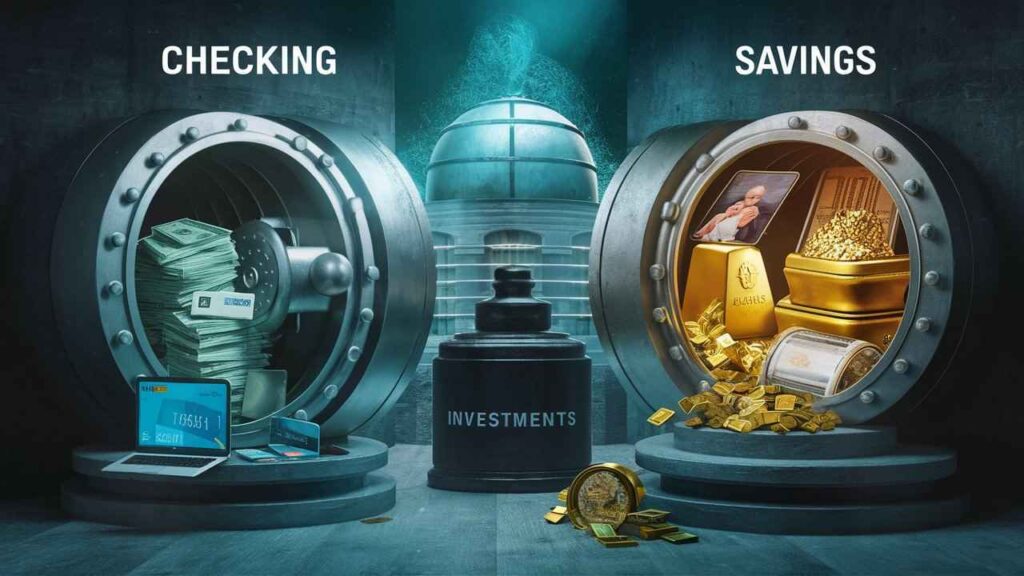Why It Matters Where You Keep Your Cash
Money loves a good home, but not all homes are created equal. Keeping cash in the right account is like assigning your money the perfect job🤑it ensures efficiency, growth, and security. A checking account is your daily workhorse, while saving is the dreamy getaway fund that earns a little on the side. Balancing them strategically is the secret sauce to financial wellness.

The Common Pitfall of Mismanaging Account Balances
Let’s face it🤑too much cash in your checking account is like overpacking your carry-on. Meanwhile, neglecting your saving is akin to skipping sunscreen on a beach vacation🤑painful. Mismanaging your balances can lead to missed interest, unnecessary fees, and financial anxiety.
TAKING in Checking Accounts
What Is a Checking Account and What Is It For
A checking account is designed for frequent transactions. Think of it as the financial equivalent of a revolving door🤑it’s where your money comes in and goes out to cover bills, groceries, and that irresistible coffee habit. Most banks, such as Chase or Bank of America, offer these accounts with features like debit cards and online access.
The Pros and Cons of Using a Checking Account for Cash
Pros: Instant access, unlimited transactions, and payment convenience.
Cons: Low or no interest and a tendency to get drained faster than your phone battery.
When to Rely on Your Checking Account the Most
Your checking account is for now, not forever. Use it to pay recurring expenses, handle day-to-day transactions, and maintain a buffer for minor emergencies.

The Role of Savings Accounts
What a Savings Account Brings to the Table
Savings accounts are the calm oasis in the wild jungle of spending. They’re built to help you grow your cash safely, offering a steady (albeit modest) interest rate.🤑
Why Savings Accounts Are More Than Just Money Holders
With saving, you’re not just parking your money; you’re putting it to work. Many banks, like Ally Bank or Capital One, provide features such as automatic transfers and high-yield interest rates that keep your funds thriving.
The Perks of Interest: Growing Your Cash the Smart Way
Even a small interest rate compounds over time. Imagine your money throwing a mini party every day it sits in saving. That’s what growth feels like, especially with high-yield accounts.🤑
How Much Cash Should Stay in Your Checking Account
Covering Your Monthly Expenses: The 1-2 Month Rule
Keep enough in your checking account to cover 1-2 months of expenses. This ensures you’re always ready for bills and essentials without overloading the account.
Accounting for Emergency Funds in Your Checking Account
While the bulk of your emergency fund belongs in saving, a small cushion in your checking account🤑say $500 to $1,000🤑can save the day.
Avoiding Overdrafts Without Overstuffing
Overdraft fees are the enemy. By maintaining a buffer, you dodge these fees while leaving the heavy lifting to your saving account.

How Much Cash to Keep in Your Savings Account
The Three-to-Six-Month Rule for Savings Safety Nets
Experts recommend having 3-6 months’ worth of expenses in your saving. This acts as a financial parachute during tough times.🤑
Long-Term Goals: Saving for Big Dreams
Dreaming of a house, vacation, or retirement? Your saving account is the launchpad. Plan and deposit consistently to watch those dreams materialize.
Emergency Funds in Savings: What’s Enough
For true emergencies, like job loss or medical crises, stash away a minimum of three months’ expenses. If you’re self-employed, aim for six.🤑

Balancing the Two Accounts Strategically
Why Too Much in Checking Can Hurt Your Savings Growth
Cash in your checking account isn’t growing🤑it’s lounging. Shift the excess to saving to harness interest benefits.
Why Too Little in Checking Could Lead to Financial Chaos
Running your checking account too lean risks overdraft fees and missed payments. Balance is key.
The Golden Ratio for Checking and Saving Balances
Try keeping 80% of your liquid cash in saving and 20% in checking account. This ensures accessibility without sacrificing growth.🤑

Situational Adjustments to Your Balances
Seasonal Expenses and Adjusting Your Checking Account
Holidays, vacations, or tax season? Bump up your checking account temporarily to cover extra spending.
When Big Life Events Call for More in Savings
Marriage, a new baby, or buying a home? Funnel extra into your saving to prepare for larger expenses.
Adjusting Balances for High-Interest Periods
If interest rates rise, consider shifting more funds into a high-yield saving account to maximize returns.

Tools and Tricks to Manage Your Balances
Automating Transfers Between Checking and Savings
Set up automatic transfers to funnel money into saving without lifting a finger. It’s budgeting made lazy (and effective).🤑
Using Banking Apps to Monitor and Optimize Balances
Apps like Mint or Personal Capital help track spending, optimize cash flow, and prevent overloading one account.
Setting Alerts to Avoid Overdrafts or Low Funds
Most banks allow you to set alerts for low balances. These nudges are lifesavers for your checking account.🤑
Common Mistakes People Make
Hoarding Too Much Cash in Checking Accounts
Leaving too much in your checking account is like hiding cash under your mattress🤑safe, but not smart.
Ignoring Savings Opportunities Due to Fear of Inaccessibility
Modern saving accounts are accessible and flexible. Don’t let old myths stop you from growing your funds.
Forgetting to Adjust for Inflation in Savings
Inflation erodes your cash’s value. Regularly move excess funds into higher-yield options.
Frequently Asked Questions
Can You Have Too Much Cash in Your Checking Account
Yes, and it’s a waste. Excess cash belongs in saving, where it can earn interest.
What Happens If You Don’t Use Your Savings Account Regularly
You miss out on growth opportunities and could incur inactivity fees in some cases.
How Can You Quickly Build a Healthy Savings Balance
Automate deposits, cut unnecessary expenses, and redirect bonuses or windfalls into saving.
Conclusion
The Importance of Finding Your Financial Sweet Spot
Your money deserves a system that works for you. Balancing your checking account and saving wisely ensures peace of mind and financial stability.
Why Smart Cash Allocation Is Key to Financial Success
A little planning goes a long way. Let your checking account and saving team up to crush your money goals.
Your Next Steps to Mastering Checking vs Saving Balances
Review your balances, set up automated transfers, and adjust based on your goals. The future of your finances starts now.
People Also Ask
Is it better to have a checking or savings account?
It depends on your financial needs. A checking account is ideal for daily transactions and bills, while a savings account is better for storing and growing money over time.
What is the difference between a savings account and a chequing account?
A checking account is for frequent transactions like bill payments, while a savings account is designed to store funds, often earning interest with limited access.
Is a debit card a checking or savings account?
A debit card is typically linked to a checking account, allowing you to access funds for daily expenses. However, some debit cards can also be linked to a savings account.
What is a disadvantage of a checking account?
One major disadvantage of a checking account is the lack of interest earnings. Your money doesn’t grow, and some accounts may also have high fees.
Is checking account worth it?
Yes, a checking account is worth it for managing day-to-day financial activities like paying bills, but pairing it with a savings account ensures financial growth.
Is it safe to keep money in checking or savings?
Both accounts are generally safe, especially if insured by FDIC or NCUA. However, a savings account offers added security against overspending.
Can I move money from checking to savings?
Yes, you can transfer funds from your checking account to your savings account easily through online banking or in person at your bank.
Should I type account checking or savings?
It depends on your needs. Use a checking account for frequent transactions and a savings account for storing funds.
Can I withdraw all my money from my checking account?
Yes, you can withdraw all your money from your checking account, but be cautious of potential overdrafts or pending payments.
How do I know if my account is checking or savings?
Check your account type on your bank statement, mobile app, or ask your bank. Checking accounts are used for transactions; savings accounts focus on storage and growth.
Can you have a savings account without a checking account?
Yes, you can open a savings account without a checking account, though having both provides better financial flexibility.
Can I pay bills with a savings account?
In most cases, you cannot pay bills directly from a savings account, as it is not designed for frequent transactions. Use a checking account instead.
What is the risk of a checking account?
The primary risks include overdraft fees, fraud, and lack of interest earnings. Keeping a small balance can minimize these risks.
How many times can I transfer money from savings to checking Capital One?
Capital One allows unlimited transfers between your savings account and checking account since the federal transfer limit no longer applies.
Is it bad to only have a checking account?
Relying solely on a checking account can hinder savings growth and emergency fund planning. Pairing it with a savings account is smarter.
What is one disadvantage of a checking account?
One major disadvantage is the lack of interest, meaning your money doesn’t grow while sitting in the account.
How much money should you keep in a checking account?
Keep 1-2 months’ worth of expenses in your checking account to avoid overdrafts while ensuring the rest is saved or invested.
Can I have both a checking and savings account?
Yes, and it’s highly recommended. A checking account handles daily transactions, while a savings account builds financial security.
Is it OK to leave money in checking account?
It’s okay, but leaving too much in a checking account means missing out on potential interest from a savings account.
Which bank is safest from hackers?
Banks with robust security features, such as Chase, Wells Fargo, and Bank of America, are considered safer. Look for FDIC-insured institutions with two-factor authentication.
How long does it take for a $30,000 check to clear?
Large checks, like a $30,000 deposit, can take up to 7 business days to clear, depending on the bank’s policies and your account history.









